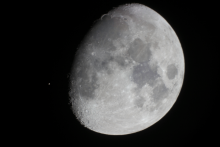Listen to today's episode of StarDate on the web the same day it airs in high-quality streaming audio without any extra ads or announcements. Choose a $8 one-month pass, or listen every day for a year for just $30.
You are here
Moon and Aldebaran
Astronomers spent decades hunting for planets around the star Aldebaran, the bright orange “eye” of the bull. And they found one. But their work also revealed details about Aldebaran itself.
The astronomers looked at Aldebaran hundreds of times with telescopes at McDonald Observatory and elsewhere. They measured a small shift in its light caused by the gravitational tug of the planet.
A few years ago, other astronomers combined those observations with some made by a space telescope. They found changes on the surface of Aldebaran caused by sound waves rippling through its interior. How the waves move through the star reveals important details about how the star is put together, just as sound waves moving through Earth reveal details about how it’s put together.
Those details helped revise much of our knowledge of Aldebaran. They showed that it’s only about 16 percent heavier than the Sun — a good bit less massive than earlier estimates. They also showed that it’s about six-and-a-half billion years old — a couple of billion years older than the Sun.
So the hunt for planets around other stars is also helping us learn about the stars themselves.
Aldebaran is especially easy to find the next couple of nights because it’s close to the Moon. It rises a little below the Moon early this evening, and about the same distance to the right of the Moon tomorrow night. The two bodies will stay close together throughout both nights.
Script by Damond Benningfield




